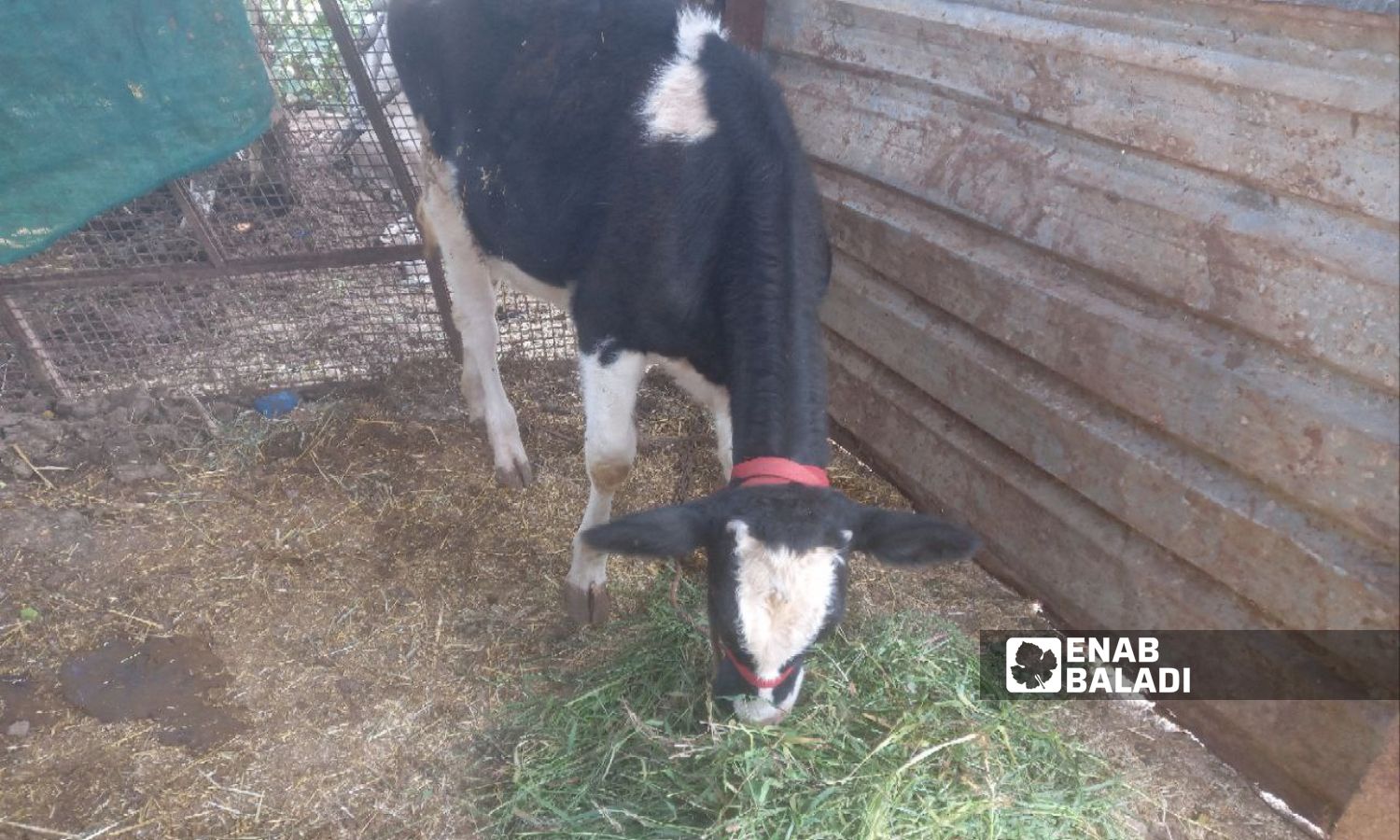



Daraa – Halim Muhammad
Cow prices rose in Daraa governorate, southern Syria, coinciding with the rise in the price of milk and meat in the local market, amid the suffering of cow breeders over the past years and their financial losses as a result of the high price of fodder and costs.
Local cow breeders told Enab Baladi that there is no significant profit when the price of feed exceeds the price of milk.
The prices of some cows in the countryside of Daraa exceeded 40 million Syrian pounds, coinciding with the rise in the price of milk, the price of one kilo of which reached 5,000 Syrian pounds. The merchant buys it directly from the breeder, while a kilo of fodder reaches 3,500 Syrian pounds.
($1=13,900 SYP) according to the S-P Today website, which covers the trading rate of the Syrian pound to the dollar.
Youssef al-Mohammad, a cow trader from the western countryside of Daraa, told Enab Baladi that there are several factors that determine the price of cows, including their breed.
The Holstein Friesian is considered the most famous and expensive group of breeds of dairy cattle in Daraa, and it has become rare, especially after the destruction of the General Cattle Company and the Libyan Joint Company in the western countryside of Daraa, which contained these cows. After 2012, they were subjected to theft, vandalism of facilities, and the loss of a large part of this breed.
One of the most important factors in determining the price of a cow is its milk production, and there are cows that produce more than 35 kilograms of milk per day, as the price of a cow that produces this quantity differs from that of a cow that produces 15 kilograms, for example, and whose price does not exceed 20 million Syrian pounds, according to al-Mohammad.
He added that the age factor also affects the price, as the price of cows increases the younger they are, and the criterion for determining age starts from the stage of their entry into production and the number of their births.
Saleh, 40, a cow trader based in the western countryside of Daraa, told Enab Baladi that the high price of milk played a role in the breeder’s adherence to raising his cows and refusing to sell them after achieving a profit margin resulting from the increase in the price of milk over the price of fodder, in addition to the presence of another reason related to the high prices of livestock meat in general.
He added that cows and calves are sometimes sold to meat slaughterhouses, which raises their price in the local market.
The increase was not limited to milk cows but included the prices of calves, and the price of any newborn is not less than 8 million pounds.
Cows have become beyond the purchasing power of a large segment of the rural population in Daraa, especially since they achieve family self-sufficiency in milk products, while they have now achieved financial returns after the recent rise in milk, according to Saleh.
Anas, 40, of Muzayrib town, said that buying a cow has become equivalent to buying a bus, as it has become beyond the means of most residents.
Anas, who works as a day laborer for 20,000 pounds, seeks to own a cow, but his financial ability does not help him buy it.
The young man added that he intends to sell his motorcycle and buy a heifer to raise, and this will take two years until he has a milk cow.
After the recent increase in milk prices, the breeder is now making a profit by selling the milk because its price exceeds the feed’s price.
Iyad, a veterinarian in the Daraa countryside, told Enab Baladi that every kilogram of fodder produces two kilograms of milk, and after the price of the latter increased, the breeder began to increase the feeding of fodder, which led to an increase in milk production.
The doctor added that the fodder makes livestock healthier, prevents them from losing weight, increases milk production, and gives newborns good health.
Zuhair, 28, who owns two cows in Tal Shihab town in the western countryside of Daraa, told Enab Baladi that he has recently been getting a profit margin that he did not get previously when the return on milk production did not cover the costs of fodder.
Last August, the price of a kilo of milk was 3,000 Syrian pounds, while the price of a kilo of feed was 3,500 Syrian pounds.
Subsidized fodder is available in agricultural associations at a price of 3,000 pounds, while the price of a kilo of fodder in private mills ranges between 3,500 and 4,000 pounds.
The high prices of livestock affected the breeder, as Zuhair sold a heifer for eight million Syrian pounds.
The military operations that Daraa governorate has witnessed since 2011 have affected the number of cows, as a number of them died as a result of battles, bombing of residential areas, or displacement operations that prompted breeders to get rid of their livestock due to the difficulty of transporting them.
The livestock breeding sector in southern Syria gradually recovered after 2018, but it was confronted by the high cost of breeding necessities and high production costs.
The high price of meat also contributed to the slaughter of female livestock, including cows, which affected the number of the cattle.
The Animal Health Department in the Daraa Agriculture Directorate said last July that the number of herds of cows in the governorate reached 43,264.
if you think the article contain wrong information or you have additional details Send Correction